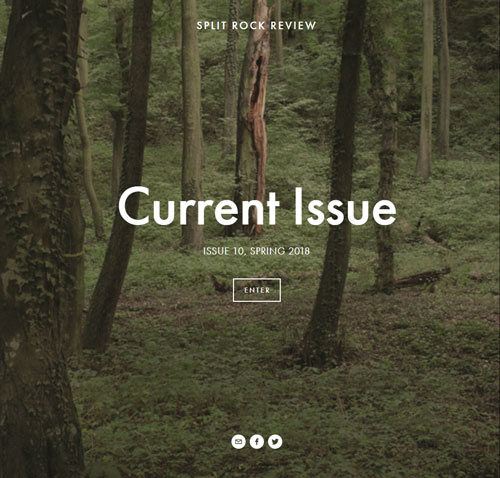Split Rock Review – Spring 2018
The image that greets readers at Split Rock Review’s Spring 2018 issue is a photograph of forest that takes up the entire computer screen. Leaves blanket the floor and climb up trees, a perfect visual companion for mid-summer reading. It’s the pieces that resonate with this image of nature that spoke to me the loudest this issue, fully immersing myself in the greens of summer.
The image that greets readers at Split Rock Review’s Spring 2018 issue is a photograph of forest that takes up the entire computer screen. Leaves blanket the floor and climb up trees, a perfect visual companion for mid-summer reading. It’s the pieces that resonate with this image of nature that spoke to me the loudest this issue, fully immersing myself in the greens of summer.
Kathleen Bangs writes about the forest in the nonfiction piece “Cold Woods,” which begins with an air of mystery to draw readers in: “When he went missing, officials said maybe he got swallowed up by a peat bog.” This mystery is never quite cleared up as Bangs uses it to expand upon the fallibility of memory. The story of a missing man, Dave Shippee, lends opportunity to explore the dark woods of memory and storytelling. Bangs is unable to find more information about this missing man and instead uncovers another missing man with the same name. In her searching, she brings back the idea of disappearing into peat bog and applies that to her own memory: “It’s the kind of scenario that could drive you a little bit crazy. And [ . . . ] this could push you almost over the edge. Right into the void of an existential peat bog.” As she takes us full circle, Bangs invites us to question our own dark stories or bogged down memories and the way these shape our storytelling.
Jenny Godwin explores the way water shapes land and the humans living on the land in “Promise Me Water.” The speaker regards the river running through the land as something almost religious:
I won’t call it a blessing
if you don’t want
me to, but it is.
Won’t hold your hands like
a prayer, but I’m praying.
Won’t drink like it’s holy
but my mouth already
knows the honor.
The connection to the water is spiritual. Godwin challenges us to deny this live-giving source if we can—to denounce our faith and say we have “never laughed / with raw awe” at the land and the river running through it.
Godwin isn’t the only writer in awe of the land around them in this issue, though. My favorite poems all had a strong connection to nature. Like Godwin, the speaker in Scott T. Hutchison’s “Saving Fish” finds himself on the edge of a river as he picks blueberries. Here, he comes upon a snake eating a catfish which he decides to save, taking prey from predator, and throwing it back into the water. He wonders if the snake: “knows an empty anger, / if he glides on a hatred for creatures who deny / his appetite and need.” Running parallel to this thought, the speaker is startled by the animals around him, accidentally spilling his bucket of blueberries, leaving “nothing but a few insignificant mouthfuls / to quell my cravings.” Above, an eagle spots a bass as it leaps from the water near the speaker’s feet. The creatures—the speaker included—each seek survival around each other, each attempting to feed themselves to live, and just as he removes the meal from the snake, his meal is in turn removed from him. Maybe we’re not so different from the wild animals doing what they need to survive around us.
Wendy Oleson becomes one with the natural world, embracing the funk of the human body, the speaker “excavating the animal” within her, refusing to shower it away. Oleson puts to rest any idea that poetry needs to be pretty. In fact, her poem is borderline gross:
the day-to-day
disgusting—ear wax,
dandruff, bellybutton
grit? Crusted
mustard under
fingernails?
But there’s a tenderness, a feeling of affection, that she cultivates which makes even the “day-to-day disgusting” a welcome, wanted presence.
Beverly Burch takes a different approach in “Psalm of the Glass City.” In this poem, the forest is seen in a city: “the forests of glazed towers—” and mountains are reflected in the windows. Rooftop gardens boast “Figs, almonds and willows,” and “Bee and bee-eater / nest in parapets.” But while there are some signs of nature in this city, many more have been driven out, and mosses and trees have been destroyed to make room for more cities. Burch ends, asking the question “Who remembers native earth raising / red cedars? They alone scraped the sky.” Burch reminds us that as we enjoy the nature that’s highlighted in the other poems in this issue, we’re only seeing a fraction of what was once there. We’re often only seeing a reflection in windows instead of the real thing.
Jury S. Judge makes a comment along a similar vein with the comic “Selfie/Self-Obsessed Culture” which features a family standing in front of the Grand Canyon, backs to the view as they hold their phones up in selfie-position. With nine words “Folks, the view of Grand Canyon is THIS WAY,” Judge makes the reminder to set down our phones, forget our Instagram feeds, and pay attention to the real beauty around us.
The summer may be beginning to wind down to a close, but you still have plenty of time to enjoy the nature it has to offer. Whether you take a hike to collect blueberries, acknowledge the power of rivers, stew in your sweat, or navigate to this issue of Split Rock Review, be sure to carve out a little bit of time to enjoy what we have while we have it.
[www.splitrockreview.org]






